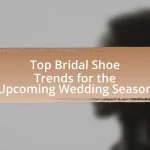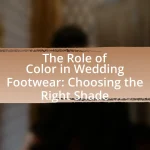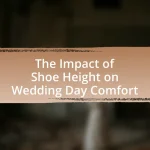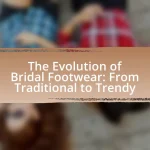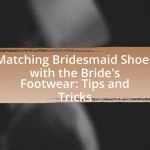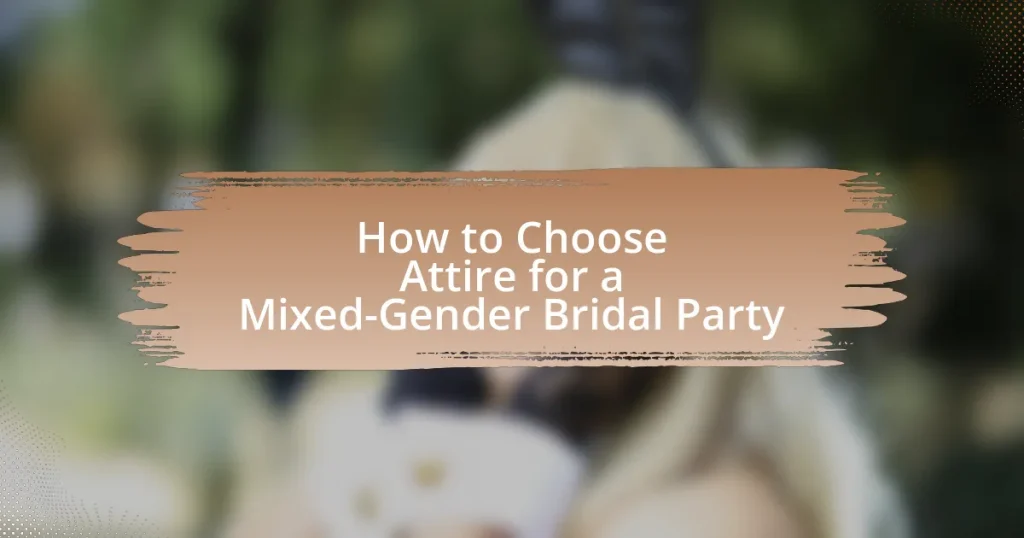The article focuses on the essential factors to consider when selecting attire for a mixed-gender bridal party, emphasizing inclusivity, comfort, color scheme, and style cohesion. It explores how personal styles influence attire choices, highlighting key elements such as fit, color, and fabric that contribute to a cohesive look while allowing individual expression. The article also discusses the impact of wedding themes on attire selection, offering practical tips for coordinating diverse styles and ensuring comfort throughout the event. Additionally, it addresses best practices for fostering inclusivity and managing budget considerations, while identifying common pitfalls to avoid in the attire selection process.

What Factors Should Be Considered When Choosing Attire for a Mixed-Gender Bridal Party?
When choosing attire for a mixed-gender bridal party, factors such as inclusivity, comfort, color scheme, and style cohesion should be considered. Inclusivity ensures that all members feel represented and comfortable in their attire, which can involve selecting gender-neutral options or allowing personal expression within a defined theme. Comfort is crucial, as bridal party members will be wearing their outfits for extended periods; therefore, fabric choice and fit should accommodate various body types and preferences. The color scheme should align with the overall wedding theme, ensuring that all attire complements each other visually. Finally, style cohesion is important to create a unified look, which can be achieved through coordinating elements like accessories or patterns while allowing for individual expression.
How do personal styles influence attire choices for a mixed-gender bridal party?
Personal styles significantly influence attire choices for a mixed-gender bridal party by reflecting individual preferences and aesthetics in the overall wedding theme. Each member’s unique style can dictate the color palette, fabric selection, and silhouette of their attire, ensuring that everyone feels comfortable and authentic on the wedding day. For instance, a member who prefers a bohemian style may choose flowing fabrics and earthy tones, while another with a classic style might opt for tailored suits or elegant dresses. This diversity in personal styles not only enhances the visual appeal of the bridal party but also fosters inclusivity, allowing each individual to express their identity while contributing to a cohesive look that aligns with the couple’s vision for their wedding.
What are the key elements of personal style to consider?
The key elements of personal style to consider include fit, color, fabric, and personal expression. Fit is crucial as it determines how well the clothing complements an individual’s body shape, enhancing overall appearance. Color selection should align with personal preferences and the event’s theme, influencing mood and visual impact. Fabric choice affects comfort and appropriateness for the occasion, with options ranging from formal to casual materials. Lastly, personal expression allows individuals to showcase their unique identity through accessories, patterns, and styles, making the attire feel authentic. These elements collectively contribute to a cohesive and stylish look suitable for a mixed-gender bridal party.
How can personal styles be harmonized within the bridal party?
Personal styles can be harmonized within the bridal party by selecting a cohesive color palette and coordinating attire that allows for individual expression. This approach ensures that while each member can showcase their unique style, the overall look remains unified. For instance, choosing a specific color scheme, such as pastels or jewel tones, allows each person to select outfits that reflect their personal taste while adhering to the chosen colors. Additionally, incorporating similar fabrics or styles, such as all members wearing either formal or semi-formal attire, can further enhance the harmony. This method is supported by the trend in modern weddings where personalization is prioritized, allowing for a blend of individuality and collective aesthetics.
What role does the wedding theme play in attire selection?
The wedding theme significantly influences attire selection by establishing a cohesive aesthetic that guides the choices of colors, styles, and fabrics. For instance, a rustic wedding theme may lead to the selection of earthy tones and casual fabrics, while a formal theme typically calls for elegant silhouettes and luxurious materials. This alignment ensures that the attire complements the overall atmosphere of the event, enhancing the visual harmony and guest experience.
How can different themes affect color and fabric choices?
Different themes significantly influence color and fabric choices in attire for a mixed-gender bridal party. For instance, a rustic theme often favors earthy tones and natural fabrics like linen or cotton, reflecting the outdoor setting and organic elements. Conversely, a formal theme typically calls for rich colors such as deep reds or navy, paired with luxurious fabrics like silk or satin to convey elegance. Historical context supports this, as traditional wedding attire has evolved to align with cultural themes, where colors and materials symbolize various meanings; for example, white represents purity in Western cultures, while red signifies good fortune in many Asian cultures. Thus, the chosen theme directly dictates the palette and textile selection, ensuring cohesion and relevance to the event’s overall aesthetic.
What are some examples of themes and corresponding attire styles?
Examples of themes and corresponding attire styles for a mixed-gender bridal party include rustic, where attire may consist of earthy tones and casual fabrics; vintage, featuring retro dresses and suits; and beach, which often involves light, breathable fabrics like linen or cotton. Each theme influences the choice of colors, materials, and overall style, ensuring that the attire aligns with the wedding’s aesthetic. For instance, a rustic theme typically emphasizes natural elements, while a vintage theme may incorporate lace and classic silhouettes, reflecting historical fashion trends.
Why is comfort important in choosing attire for a mixed-gender bridal party?
Comfort is crucial in choosing attire for a mixed-gender bridal party because it directly impacts the participants’ enjoyment and ability to engage throughout the event. When individuals feel comfortable in their clothing, they are more likely to participate actively in the ceremony and celebrations, leading to a more positive experience for everyone involved. Studies indicate that discomfort can lead to distractions and reduced participation, which can detract from the overall atmosphere of the occasion. Therefore, selecting attire that accommodates various body types and personal preferences ensures that all members of the bridal party can focus on the celebration rather than their clothing.
How can comfort be balanced with style in attire choices?
Comfort can be balanced with style in attire choices by selecting fabrics that offer breathability and flexibility while incorporating fashionable designs. For instance, choosing materials like cotton or linen allows for ease of movement and comfort, while tailored cuts and trendy patterns maintain a stylish appearance. Additionally, incorporating adjustable elements such as elastic waistbands or layered pieces can enhance comfort without sacrificing aesthetic appeal. Research indicates that attire that combines comfort and style can improve overall satisfaction, as seen in studies on consumer preferences in fashion, which highlight the importance of both factors in decision-making.
What materials are best for ensuring comfort throughout the event?
Breathable fabrics such as cotton, linen, and moisture-wicking blends are best for ensuring comfort throughout the event. Cotton is soft and allows air circulation, making it ideal for warm conditions. Linen is lightweight and has excellent moisture absorption properties, which helps keep the body cool. Moisture-wicking blends, often used in athletic wear, draw sweat away from the skin, enhancing comfort during prolonged activities. These materials are commonly recommended for events to maintain comfort levels, especially in varying temperatures and physical activities.
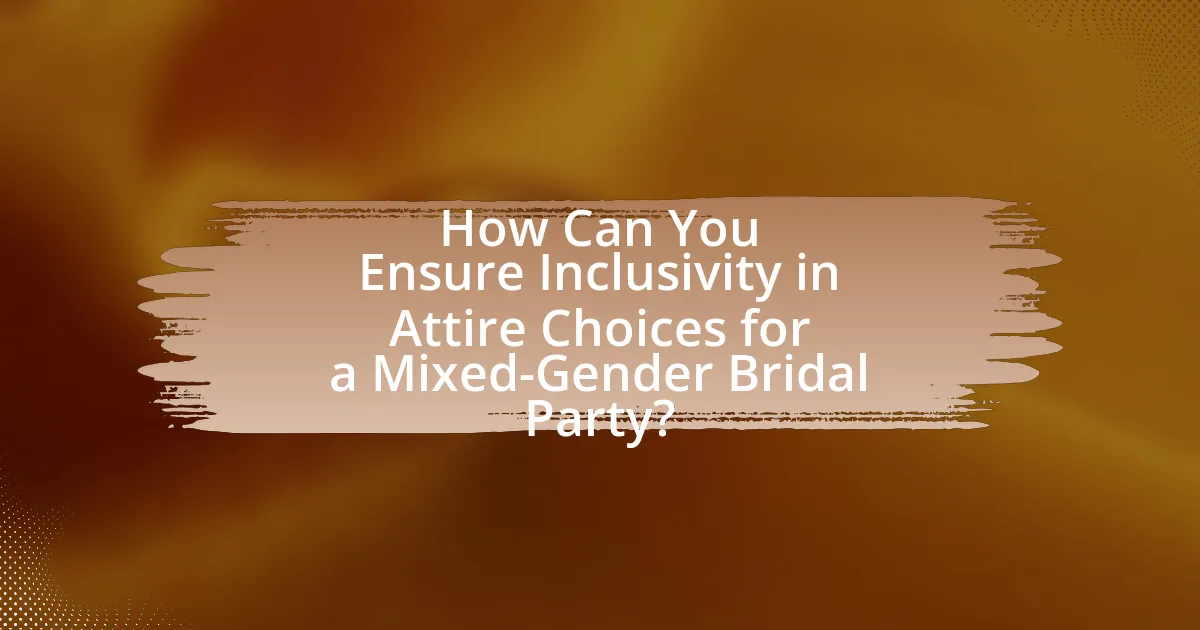
How Can You Ensure Inclusivity in Attire Choices for a Mixed-Gender Bridal Party?
To ensure inclusivity in attire choices for a mixed-gender bridal party, select outfits that allow all members to express their gender identity and personal style. This can be achieved by offering a range of options, such as suits, dresses, or gender-neutral attire, ensuring that everyone feels comfortable and represented. Research indicates that inclusive practices in wedding planning can enhance the overall experience for participants, fostering a sense of belonging and acceptance. By prioritizing diverse attire options, the bridal party can reflect the values of inclusivity and respect for individual preferences.
What are the best practices for selecting inclusive attire?
The best practices for selecting inclusive attire involve prioritizing comfort, ensuring diverse representation, and allowing personal expression. Comfort is essential as it enables all participants to feel at ease during the event, which can be achieved by choosing fabrics and styles that accommodate various body types. Diverse representation can be ensured by offering a range of options that reflect different gender identities and cultural backgrounds, thus fostering an inclusive environment. Allowing personal expression through customizable elements, such as color choices or accessory options, empowers individuals to feel authentic in their attire. These practices collectively contribute to a more inclusive and harmonious atmosphere for a mixed-gender bridal party.
How can you accommodate different body types and gender expressions?
To accommodate different body types and gender expressions in a mixed-gender bridal party, one should offer a range of attire options that include various sizes, styles, and fits. This approach ensures that all individuals feel comfortable and represented, regardless of their body shape or gender identity. For instance, providing dresses, suits, and gender-neutral options allows participants to choose what aligns with their personal style and comfort level. Research indicates that inclusive sizing and diverse styles can enhance the overall experience and satisfaction of participants, as seen in studies highlighting the importance of representation in fashion.
What styles are universally flattering for all genders?
Styles that are universally flattering for all genders include tailored blazers, well-fitted trousers, and A-line dresses. Tailored blazers create a structured silhouette that enhances body shape, while well-fitted trousers provide a polished look that suits various body types. A-line dresses are versatile and complement different figures by cinching at the waist and flowing out, creating an hourglass effect. These styles are widely recognized for their ability to enhance appearance regardless of gender, making them ideal choices for a mixed-gender bridal party.
How can communication among bridal party members enhance inclusivity?
Effective communication among bridal party members enhances inclusivity by ensuring that all voices and preferences are heard and considered during the planning process. When bridal party members openly share their thoughts on attire, it fosters a collaborative environment where everyone feels valued, regardless of gender. This approach can lead to attire choices that reflect the diverse identities and styles of the group, promoting a sense of belonging. Research indicates that inclusive decision-making processes can improve group cohesion and satisfaction, as seen in studies on team dynamics in various settings. By prioritizing communication, bridal parties can create a more harmonious and inclusive experience for all participants.
What questions should be asked to gauge preferences and comfort levels?
To gauge preferences and comfort levels for attire in a mixed-gender bridal party, ask questions such as: “What styles do you feel most comfortable wearing?” and “Are there any colors or patterns you prefer or wish to avoid?” These questions directly address individual comfort and style preferences, which are crucial for ensuring that all members feel confident and at ease in their attire. Additionally, inquire about specific fit preferences by asking, “Do you prefer fitted or loose clothing?” This helps to accommodate varying body types and personal tastes. Research indicates that when individuals feel comfortable in their clothing, it positively impacts their overall experience and enjoyment of the event.
How can feedback be incorporated into the final attire decisions?
Feedback can be incorporated into final attire decisions by systematically gathering input from all members of the bridal party regarding their preferences and comfort levels. This can be achieved through surveys or discussions that focus on specific elements such as color, style, and fit. For instance, a study published in the Journal of Fashion Marketing and Management highlights that inclusive decision-making processes lead to higher satisfaction among participants. By analyzing this feedback, organizers can make informed adjustments to the attire that reflect the collective desires of the group, ensuring that everyone feels represented and comfortable on the wedding day.
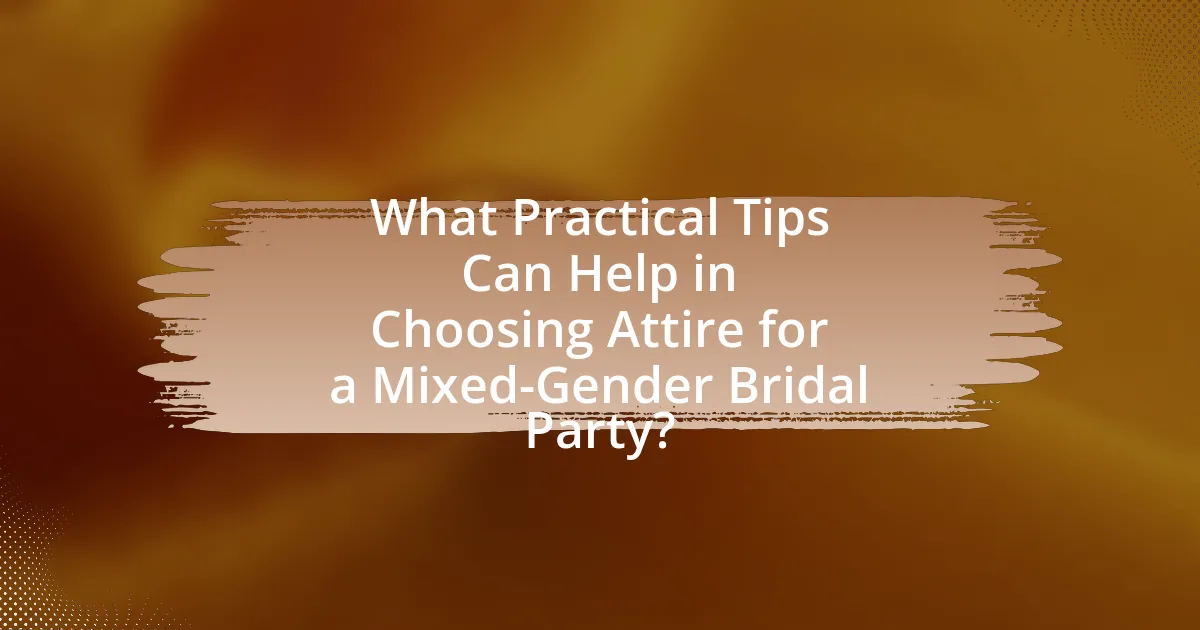
What Practical Tips Can Help in Choosing Attire for a Mixed-Gender Bridal Party?
To choose attire for a mixed-gender bridal party, prioritize inclusivity and comfort by selecting a color palette and style that accommodates all body types and gender expressions. This approach ensures that everyone feels represented and comfortable in their attire. Additionally, consider coordinating outfits that allow for individual expression while maintaining a cohesive look, such as matching accessories or complementary colors. Research indicates that inclusive attire choices can enhance the overall experience for participants, fostering a sense of belonging and celebration.
How can you effectively coordinate attire among diverse members?
To effectively coordinate attire among diverse members, establish a clear theme or color palette that accommodates various styles and preferences. This approach allows each member to express their individuality while maintaining a cohesive look. For instance, selecting a specific color scheme, such as pastels or jewel tones, enables members to choose outfits that reflect their personal style within the defined parameters. Research indicates that visual harmony in group attire can enhance the overall aesthetic and create a unified appearance, which is particularly important in settings like weddings where diverse participants are involved.
What tools or resources can assist in coordinating looks?
Fashion coordination apps, such as Stylebook and Cladwell, assist in coordinating looks for a mixed-gender bridal party by allowing users to create outfits from their existing wardrobe and visualize combinations. These tools enable users to upload images of their clothing, categorize items, and generate outfit ideas, which facilitates collaboration among party members. Additionally, Pinterest serves as a valuable resource for gathering inspiration and sharing ideas, as users can create boards specifically for the bridal party’s attire. Studies show that visual tools enhance decision-making in fashion coordination, making these resources effective for achieving a cohesive look.
How can you manage budget considerations while ensuring style and comfort?
To manage budget considerations while ensuring style and comfort, prioritize versatile pieces that can be worn again in different settings. Selecting attire that combines classic styles with comfortable fabrics allows for a balance between aesthetics and wearability. For instance, choosing dresses or suits made from breathable materials like cotton or linen can enhance comfort without sacrificing style. Additionally, setting a clear budget for each outfit and exploring rental options or second-hand stores can significantly reduce costs while still achieving a fashionable look. Research indicates that the average cost of wedding attire can be reduced by up to 50% through these methods, making it feasible to maintain both style and comfort within budget constraints.
What are common pitfalls to avoid when selecting mixed-gender attire?
Common pitfalls to avoid when selecting mixed-gender attire include failing to consider body types and personal styles, which can lead to discomfort and dissatisfaction among participants. Additionally, neglecting to establish a cohesive color palette or theme may result in a disjointed appearance, undermining the overall aesthetic of the bridal party. It’s also important to avoid choosing overly formal or casual attire that does not align with the event’s tone, as this can create confusion and inconsistency. Lastly, overlooking the importance of fit and comfort can lead to wardrobe malfunctions or discomfort during the event, detracting from the experience.
How can you prevent mismatched styles or colors?
To prevent mismatched styles or colors in a mixed-gender bridal party, establish a cohesive color palette and style guide early in the planning process. This approach ensures that all participants understand the desired aesthetic and can select attire that aligns with the chosen theme. Research indicates that having a defined color scheme, such as three to five complementary colors, helps maintain visual harmony, as supported by studies on color theory in design. Additionally, providing examples of acceptable styles, such as specific dress codes or fabric types, further minimizes the risk of mismatches.
What strategies can help in addressing last-minute changes or issues?
To effectively address last-minute changes or issues in a mixed-gender bridal party attire selection, proactive communication and flexibility are essential strategies. Proactive communication ensures that all members are informed about potential changes and can voice concerns or preferences, which fosters collaboration and minimizes misunderstandings. Flexibility allows the bridal party to adapt quickly to unforeseen circumstances, such as size adjustments or style modifications, ensuring that everyone feels comfortable and included. Research indicates that effective communication within teams can enhance problem-solving capabilities, as highlighted in a study by the Project Management Institute, which found that clear communication significantly reduces project risks.
